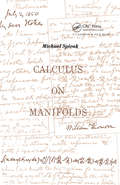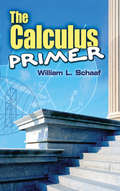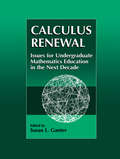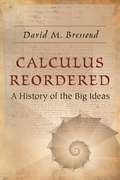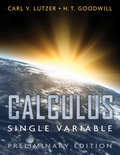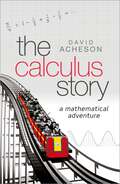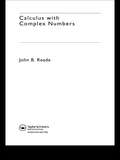- Table View
- List View
Calculus on Heisenberg Manifolds. (AM-119), Volume 119 (PDF)
by Richard Beals Peter Charles GreinerThe description for this book, Calculus on Heisenberg Manifolds. (AM-119), Volume 119, will be forthcoming.
Calculus On Manifolds: A Modern Approach To Classical Theorems Of Advanced Calculus
by Michael SpivakThis little book is especially concerned with those portions of ?advanced calculus? in which the subtlety of the concepts and methods makes rigor difficult to attain at an elementary level. The approach taken here uses elementary versions of modern methods found in sophisticated mathematics. The formal prerequisites include only a term of linear algebra, a nodding acquaintance with the notation of set theory, and a respectable first-year calculus course (one which at least mentions the least upper bound (sup) and greatest lower bound (inf) of a set of real numbers). Beyond this a certain (perhaps latent) rapport with abstract mathematics will be found almost essential.
Calculus on Normed Vector Spaces (Universitext)
by Rodney ColemanThis book serves as an introduction to calculus on normed vector spaces at a higher undergraduate or beginning graduate level. The prerequisites include basic calculus and linear algebra, as well as a certain mathematical maturity. All the important topology and functional analysis topics are introduced where necessary.In its attempt to show how calculus on normed vector spaces extends the basic calculus of functions of several variables, this book is one of the few textbooks to bridge the gap between the available elementary texts and high level texts. The inclusion of many non-trivial applications of the theory and interesting exercises provides motivation for the reader.
Calculus (PDF)
by Michael SpivakSpivak's celebrated textbook is widely held as one of the finest introductions to mathematical analysis. His aim is to present calculus as the first real encounter with mathematics: it is the place to learn how logical reasoning combined with fundamental concepts can be developed into a rigorous mathematical theory rather than a bunch of tools and techniques learned by rote. Since analysis is a subject students traditionally find difficult to grasp, Spivak provides leisurely explanations, a profusion of examples, a wide range of exercises and plenty of illustrations in an easy-going approach that enlightens difficult concepts and rewards effort. Calculus will continue to be regarded as a modern classic, ideal for honours students and mathematics majors, who seek an alternative to doorstop textbooks on calculus, and the more formidable introductions to real analysis.
The Calculus Primer
by William L. SchaafComprehensive but concise, this introduction to differential and integral calculus covers all the topics usually included in a first course. The straightforward development places less emphasis on mathematical rigor, and the informal manner of presentation sets students at ease. Many carefully worked-out examples illuminate the text, in addition to numerous diagrams, problems, and answers.Bearing the needs of beginners constantly in mind, the treatment covers all the basic concepts of calculus: functions, derivatives, differentiation of algebraic and transcendental functions, partial differentiation, indeterminate forms, general and special methods of integration, the definite integral, partial integration, and other fundamentals. Ample exercises permit students to test their grasp of subjects before moving forward, making this volume appropriate not only for classroom use but also for review and home study.
Calculus Problems (UNITEXT #101)
by Marco Baronti Filippo De Mari Robertus van der Putten Irene VenturiThis book, intended as a practical working guide for calculus students, includes 450 exercises. It is designed for undergraduate students in Engineering, Mathematics, Physics, or any other field where rigorous calculus is needed, and will greatly benefit anyone seeking a problem-solving approach to calculus. Each chapter starts with a summary of the main definitions and results, which is followed by a selection of solved exercises accompanied by brief, illustrative comments. A selection of problems with indicated solutions rounds out each chapter.A final chapter explores problems that are not designed with a single issue in mind but instead call for the combination of a variety of techniques, rounding out the book’s coverage. Though the book’s primary focus is on functions of one real variable, basic ordinary differential equations (separation of variables, linear first order and constant coefficients ODEs) are also discussed. The material is taken from actual written tests that have been delivered at the Engineering School of the University of Genoa. Literally thousands of students have worked on these problems, ensuring their real-world applicability.
Calculus Renewal: Issues for Undergraduate Mathematics Education in the Next Decade
by Susan L. GanterCalculus Reform. Or, as many would prefer, calculus renewal. These are terms that, for better or worse, have become a part of the vocabulary in mathematics departments across the country. The movement to change the nature of the calculus course at the undergraduate and secondary levels has sparked discussion and controversy in ways as diverse as the actual changes. Such interactions range from "coffee pot conversations" to university curriculum committee agendas to special sessions on calculus renewal at regional and national conferences. But what is the significance of these activities? Where have we been and where are we going with calculus and, more importantly, the entire scope of undergraduate mathematics education? In April 1996, I received a fellowship from the American Educational Research Association (AERA) and the National Science Foundation (NSF). This fellowship afforded me the opportunity to work in residence at NSF on a number of evaluation projects, including the national impact of the calculus reform movement since 1988. That project resulted in countless communications with the mathematics community and others about the status of calculus as a course in isolation and as a significant player in the overall undergraduate mathematics and science experience for students (and faculty). While at NSF (and through a second NSF grant received while at the American Association for Higher Education), I also was part of an evaluation project for the Institution-wide Reform (IR) program.
Calculus Reordered: A History of the Big Ideas
by David M. BressoudHow our understanding of calculus has evolved over more than three centuries, how this has shaped the way it is taught in the classroom, and why calculus pedagogy needs to changeCalculus Reordered takes readers on a remarkable journey through hundreds of years to tell the story of how calculus evolved into the subject we know today. David Bressoud explains why calculus is credited to seventeenth-century figures Isaac Newton and Gottfried Leibniz, and how its current structure is based on developments that arose in the nineteenth century. Bressoud argues that a pedagogy informed by the historical development of calculus represents a sounder way for students to learn this fascinating area of mathematics.Delving into calculus’s birth in the Hellenistic Eastern Mediterranean—particularly in Syracuse, Sicily and Alexandria, Egypt—as well as India and the Islamic Middle East, Bressoud considers how calculus developed in response to essential questions emerging from engineering and astronomy. He looks at how Newton and Leibniz built their work on a flurry of activity that occurred throughout Europe, and how Italian philosophers such as Galileo Galilei played a particularly important role. In describing calculus’s evolution, Bressoud reveals problems with the standard ordering of its curriculum: limits, differentiation, integration, and series. He contends that the historical order—integration as accumulation, then differentiation as ratios of change, series as sequences of partial sums, and finally limits as they arise from the algebra of inequalities—makes more sense in the classroom environment.Exploring the motivations behind calculus’s discovery, Calculus Reordered highlights how this essential tool of mathematics came to be.
Calculus Revisited (Mathematics and Its Applications #554)
by R.W. CarrollIn this book the details of many calculations are provided for access to work in quantum groups, algebraic differential calculus, noncommutative geometry, fuzzy physics, discrete geometry, gauge theory, quantum integrable systems, braiding, finite topological spaces, some aspects of geometry and quantum mechanics and gravity.
Calculus Set Free: Infinitesimals to the Rescue
by C. Bryan DawsonCalculus Set Free: Infinitesimals to the Rescue is a single-variable calculus textbook that incorporates the use of infinitesimal methods. The procedures used throughout make many of the calculations simpler and the concepts clearer for undergraduate students, heightening success and easing a significant burden of entry into STEM disciplines. This text features a student-friendly exposition with ample marginal notes, examples, illustrations, and more. The exercises include a wide range of difficulty levels, stretching from very simple "rapid response" questions to the occasional exercise meant to test knowledge. While some exercises require the use of technology to work through, none are dependent on any specific software. The answers to odd-numbered exercises in the back of the book include both simplified and non-simplified answers, hints, or alternative answers. Throughout the text, notes in the margins include comments meant to supplement understanding, sometimes including line-by-line commentary for worked examples. Without sacrificing academic rigor, Calculus Set Free offers an engaging style that helps students to solidify their understanding on difficult theoretical calculus.
Calculus Simplified
by Oscar FernandezAn accessible, streamlined, and user-friendly approach to calculusCalculus is a beautiful subject that most of us learn from professors, textbooks, or supplementary texts. Each of these resources has strengths but also weaknesses. In Calculus Simplified, Oscar Fernandez combines the strengths and omits the weaknesses, resulting in a “Goldilocks approach” to learning calculus: just the right level of detail, the right depth of insights, and the flexibility to customize your calculus adventure.Fernandez begins by offering an intuitive introduction to the three key ideas in calculus—limits, derivatives, and integrals. The mathematical details of each of these pillars of calculus are then covered in subsequent chapters, which are organized into mini-lessons on topics found in a college-level calculus course. Each mini-lesson focuses first on developing the intuition behind calculus and then on conceptual and computational mastery. Nearly 200 solved examples and more than 300 exercises allow for ample opportunities to practice calculus. And additional resources—including video tutorials and interactive graphs—are available on the book’s website.Calculus Simplified also gives you the option of personalizing your calculus journey. For example, you can learn all of calculus with zero knowledge of exponential, logarithmic, and trigonometric functions—these are discussed at the end of each mini-lesson. You can also opt for a more in-depth understanding of topics—chapter appendices provide additional insights and detail. Finally, an additional appendix explores more in-depth real-world applications of calculus.Learning calculus should be an exciting voyage, not a daunting task. Calculus Simplified gives you the freedom to choose your calculus experience, and the right support to help you conquer the subject with confidence.· An accessible, intuitive introduction to first-semester calculus· Nearly 200 solved problems and more than 300 exercises (all with answers)· No prior knowledge of exponential, logarithmic, or trigonometric functions required· Additional online resources—video tutorials and supplementary exercises—provided
Calculus, Single Variable
by Carl V. Lutzer H. T. GoodwillStudents and math professors looking for a calculus resource that sparks curiosity and engages them will appreciate this new book. Through demonstration and exercises, it shows them how to read equations. It uses a blend of traditional and reform emphases to develop intuition. Narrative and exercises present calculus as a single, unified subject. Color is used to help them identify and interpret the parts of a mathematical model. In addition, formal proofs are preceded with informal discussions that focus on the ideas about to be presented. Then the proofs are discussed in a way that helps scientists and engineers interpret the details of the argument.
The Calculus Story: A Mathematical Adventure
by David AchesonCalculus is the key to much of modern science and engineering. It is the mathematical method for the analysis of things that change, and since in the natural world we are surrounded by change, the development of calculus was a huge breakthrough in the history of mathematics. But it is also something of a mathematical adventure, largely because of the way infinity enters at virtually every twist and turn... In The Calculus Story David Acheson presents a wide-ranging picture of calculus and its applications, from ancient Greece right up to the present day. Drawing on their original writings, he introduces the people who helped to build our understanding of calculus. With a step by step treatment, he demonstrates how to start doing calculus, from the very beginning.
The Calculus Story: A Mathematical Adventure
by David AchesonCalculus is the key to much of modern science and engineering. It is the mathematical method for the analysis of things that change, and since in the natural world we are surrounded by change, the development of calculus was a huge breakthrough in the history of mathematics. But it is also something of a mathematical adventure, largely because of the way infinity enters at virtually every twist and turn... In The Calculus Story David Acheson presents a wide-ranging picture of calculus and its applications, from ancient Greece right up to the present day. Drawing on their original writings, he introduces the people who helped to build our understanding of calculus. With a step by step treatment, he demonstrates how to start doing calculus, from the very beginning.
Calculus With Applications (Undergraduate Texts in Mathematics)
by Peter D. Lax Maria Shea TerrellBurstein, and Lax's Calculus with Applications and Computing offers meaningful explanations of the important theorems of single variable calculus. Written with students in mathematics, the physical sciences, and engineering in mind, and revised with their help, it shows that the themes of calculation, approximation, and modeling are central to mathematics and the main ideas of single variable calculus. This edition brings the innovation of the first edition to a new generation of students. New sections in this book use simple, elementary examples to show that when applying calculus concepts to approximations of functions, uniform convergence is more natural and easier to use than point-wise convergence. As in the original, this edition includes material that is essential for students in science and engineering, including an elementary introduction to complex numbers and complex-valued functions, applications of calculus to modeling vibrations and population dynamics, and an introduction to probability and information theory.
Calculus with Complex Numbers
by John B. ReadeThis practical treatment explains the applications complex calculus without requiring the rigor of a real analysis background. The author explores algebraic and geometric aspects of complex numbers, differentiation, contour integration, finite and infinite real integrals, summation of series, and the fundamental theorem of algebra. The Residue Theo
Calculus with Complex Numbers
by John B. ReadeThis practical treatment explains the applications complex calculus without requiring the rigor of a real analysis background. The author explores algebraic and geometric aspects of complex numbers, differentiation, contour integration, finite and infinite real integrals, summation of series, and the fundamental theorem of algebra. The Residue Theo
Calculus with Curvilinear Coordinates: Problems And Solutions
by Markus AntoniThis book presents problems and solutions in calculus with curvilinear coordinates. Vector analysis can be performed in different coordinate systems, an optimal system considers the symmetry of the problem in order to reduce calculatory difficulty. The book presents the material in arbitrary orthogonal coordinates, and includes the discussion of parametrization methods as well as topics such as potential theory and integral theorems. The target audience primarily comprises university teachers in engineering mathematics, but the book may also be beneficial for advanced undergraduate and graduate students alike.
Calculus with Vectors (Springer Undergraduate Texts in Mathematics and Technology)
by Jay S. TreimanCalculus with Vectors grew out of a strong need for a beginning calculus textbook for undergraduates who intend to pursue careers in STEM fields. The approach introduces vector-valued functions from the start, emphasizing the connections between one-variable and multi-variable calculus. The text includes early vectors and early transcendentals and includes a rigorous but informal approach to vectors. Examples and focused applications are well presented along with an abundance of motivating exercises.The approaches taken to topics such as the derivation of the derivatives of sine and cosine, the approach to limits and the use of "tables" of integration have been modified from the standards seen in other textbooks in order to maximize the ease with which students may comprehend the material. Additionally, the material presented is intentionally non-specific to any software or hardware platform in order to accommodate the wide variety and rapid evolution of tools used. Technology is referenced in the text and is required for a good number of problems.
Calculus Without Derivatives (Graduate Texts in Mathematics #266)
by Jean-Paul PenotCalculus Without Derivatives expounds the foundations and recent advances in nonsmooth analysis, a powerful compound of mathematical tools that obviates the usual smoothness assumptions. This textbook also provides significant tools and methods towards applications, in particular optimization problems. Whereas most books on this subject focus on a particular theory, this text takes a general approach including all main theories. In order to be self-contained, the book includes three chapters of preliminary material, each of which can be used as an independent course if needed. The first chapter deals with metric properties, variational principles, decrease principles, methods of error bounds, calmness and metric regularity. The second one presents the classical tools of differential calculus and includes a section about the calculus of variations. The third contains a clear exposition of convex analysis.
Calculus Workbook For Dummies
by Mark RyanThe easy way to conquer calculus Calculus is hard—no doubt about it—and students often need help understanding or retaining the key concepts covered in class. Calculus Workbook For Dummies serves up the concept review and practice problems with an easy-to-follow, practical approach. Plus, you’ll get free access to a quiz for every chapter online. With a wide variety of problems on everything covered in calculus class, you’ll find multiple examples of limits, vectors, continuity, differentiation, integration, curve-sketching, conic sections, natural logarithms, and infinite series. Plus, you’ll get hundreds of practice opportunities with detailed solutions that will help you master the math that is critical for scoring your highest in calculus. Review key concepts Take hundreds of practice problems Get access to free chapter quizzes online Use as a classroom supplement or with a tutor Get ready to quickly and easily increase your confidence and improve your skills in calculus.
Calculus Workbook For Dummies
by Mark RyanThe easy way to conquer calculus Calculus is hard—no doubt about it—and students often need help understanding or retaining the key concepts covered in class. Calculus Workbook For Dummies serves up the concept review and practice problems with an easy-to-follow, practical approach. Plus, you’ll get free access to a quiz for every chapter online. With a wide variety of problems on everything covered in calculus class, you’ll find multiple examples of limits, vectors, continuity, differentiation, integration, curve-sketching, conic sections, natural logarithms, and infinite series. Plus, you’ll get hundreds of practice opportunities with detailed solutions that will help you master the math that is critical for scoring your highest in calculus. Review key concepts Take hundreds of practice problems Get access to free chapter quizzes online Use as a classroom supplement or with a tutor Get ready to quickly and easily increase your confidence and improve your skills in calculus.
Calderon-Zygmund Operators, Pseudo-Differential Operators and the Cauchy Integral of Calderon (Lecture Notes in Mathematics #994)
by J.-L. JourneCalkin Algebras and Algebras of Operators on Banach Spaces
by S.R. Caradus W.E. Pfaffenberger Bertram ToodSince the appearance of Banach algebra theory, the interaction between the theories ofBanach algebras with involution and that of bounded linear operators on a Hilbert space hasbeen extensively developed. The connections of Banach algebras with the theory ofbounded linear operators on a Hilbert space have also evolved, and Calkin Algebras andAlgebras of Operators on Banach Spaces provides an introduction to this set of ideas.The book begins with a treatment of the classical Riesz-Schauder theory which takesadvantage of the most recent developments-some of this material appears here for the firsttime. Although the reader should be familiar with the basics of functional analysis, anintroductory chapter on Banach algebras has been included. Other topics dealt with includeFredholm operators, semi-Fredholm operators, Riesz operators. and Calkin algebras.This volume will be of direct interest to both graduate students and research mathematicians.
Calkin Algebras and Algebras of Operators on Banach Spaces
by S.R. Caradus W.E. Pfaffenberger Bertram ToodSince the appearance of Banach algebra theory, the interaction between the theories ofBanach algebras with involution and that of bounded linear operators on a Hilbert space hasbeen extensively developed. The connections of Banach algebras with the theory ofbounded linear operators on a Hilbert space have also evolved, and Calkin Algebras andAlgebras of Operators on Banach Spaces provides an introduction to this set of ideas.The book begins with a treatment of the classical Riesz-Schauder theory which takesadvantage of the most recent developments-some of this material appears here for the firsttime. Although the reader should be familiar with the basics of functional analysis, anintroductory chapter on Banach algebras has been included. Other topics dealt with includeFredholm operators, semi-Fredholm operators, Riesz operators. and Calkin algebras.This volume will be of direct interest to both graduate students and research mathematicians.

